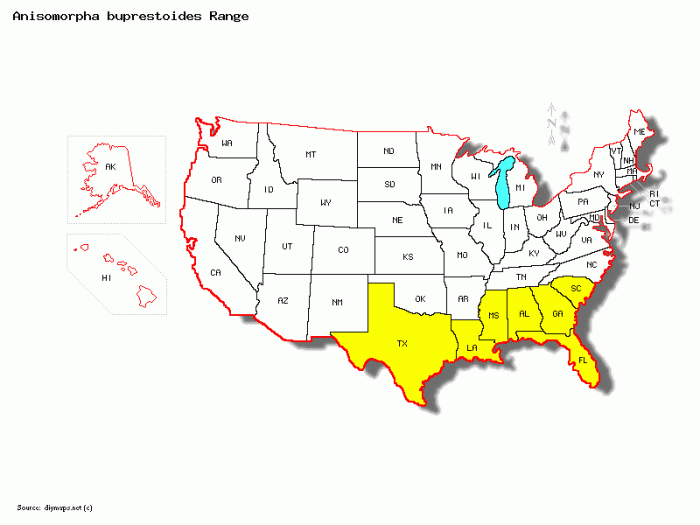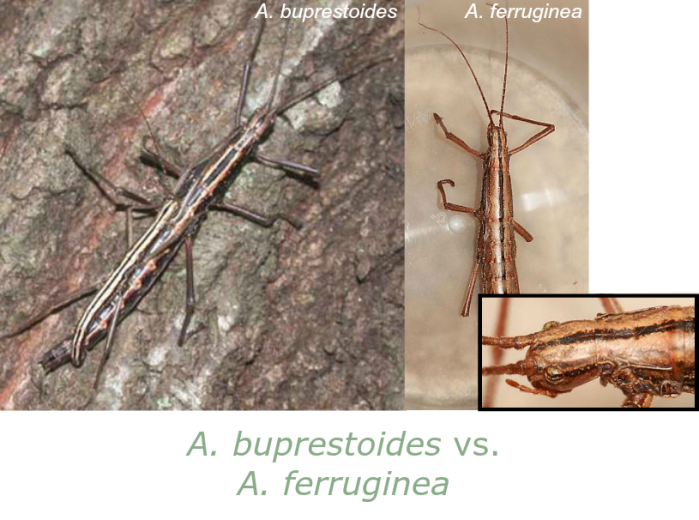
This month’s creature feature is Anisomorpha buprestoides, otherwise known as the two-striped walking stick! Let’s take a look at this common species.
Common Names
Anisomorpha buprestoides has many common names, mostly related to their startling and irritating defense response.
- two-lined/two-striped walking stick
- devil’s darning needle
- musk mare
- devil’s riding horse
- prairie alligator
- witch’s horse
- spitting devil
There may also be even more common names for this insect!
Range

The two-striped walkingstick has a fairly restricted range, mainly across the Southeastern U.S. It is prevalent from Texas to Florida and northeast to South Carolina. It’s most likely that reports of this species in Pennsylvania were falsely made, confusing A. buprestoides with the related species A. ferruginea, which look similar in immature stages.
Defense, and other Interesting Tidbits

A. buprestoides looks harmless enough (to me, anyway!) with their chubby, wingless bodies and lack of prominent pincers. However, put one under stress, and you’ll quickly see why many consider this a pest! A. buprestoides are born with special glands located on their heads. These glands are functional at birth until death. The scary part? They actually shoot poison at predators using these glands. And if you’re the one standing there poking the insect, you’re highly likely to get a shot of this powerful irritant right in your eyes. The defensive chemical will cause immediate pain in the eyes and should be rinsed thoroughly with water immediately. It is reported as being excruciating, nearly to the point of being unbearable. Please exercise caution when handling. (Or perhaps it’s best not to handle at all!) The pain will subside over the next few hours, devolving into a dull ache. You’ll probably wake up the next morning with migraine-like sensitivity to light and pressure as well as sinus pain and similar symptoms. This is all because the chemical is meant to be an eye and mucus membrane irritant. In the wild, these insects use the chemical to subdue potential predators, such as lizards, ants, mice, and opossums. This species is also known to injure domesticated dogs with their venomous spray.
This species of walking stick mates from late summer through fall. During the mating period, you will almost always see the diminutive male riding atop the long, stout female. They are best left undisturbed, as the risk for a painful spray of chemicals is present whenever you handle this species.
Without close attention to detail, A. buprestoides can easily be confused with their close relatives A. ferruginea. The trick to telling them apart lies mainly in the head region. The head of A. ferruginea is visibly fuller and less elongated than that of A. buprestoides, and the tubercles on either side of the pronotum are more pronounced, as well. A. ferruginea also features a thinner dark stripe down its center and is smaller than its relative species.
How to Find Them
As with most things, it’s easiest to find this species of walkingstick during the mating season. Throughout the late summer and fall, people living within the species range (discussed and pictured above) often find mating pairs of A. buprestoides on trees and on the sides of manmade structures. The orange and black-and-white color forms belong to intensely restricted zones and are not found at all elsewhere. So, it’s most likely that you’ll find the brown color form if you live within the distribution zone.
Speaking from personal experience, I often find mating pairs on humid nights after dark, the female clinging to the skirting on my home, the male clinging to the female. In the dark, they look like huge twelve-legged monsters! But it’s clear upon approach that it’s actually two walkingsticks. You can find individuals of this species before and sometimes after the mating season, but your best bet is to go looking during the mating season, which is late summer to fall.
Good hunting!
SOURCES:
- http://entnemdept.ufl.edu/creatures/misc/walkingstick.htm
- http://bugguide.net/node/view/233590/bgimage
- https://www.youtube.com/watch?v=eadklQyX8uk&feature=youtu.be
- https://bugmastermobile.wordpress.com/2013/09/03/caution-poison-spitting-insect-two-striped-walking-sticks/
- http://bugguide.net/node/view/17974
- http://texasento.net/sticks.htm
“Stick” around for next month’s Creature Feature!

